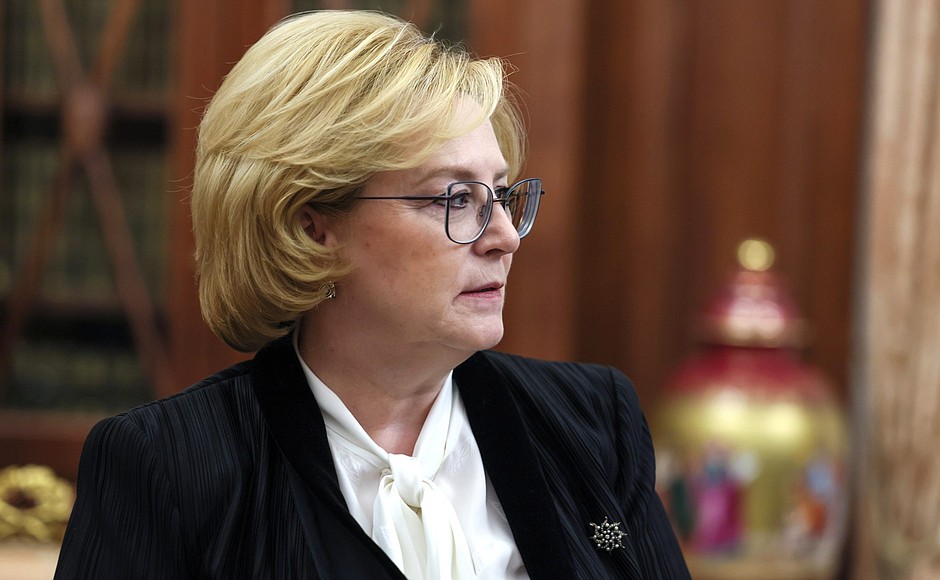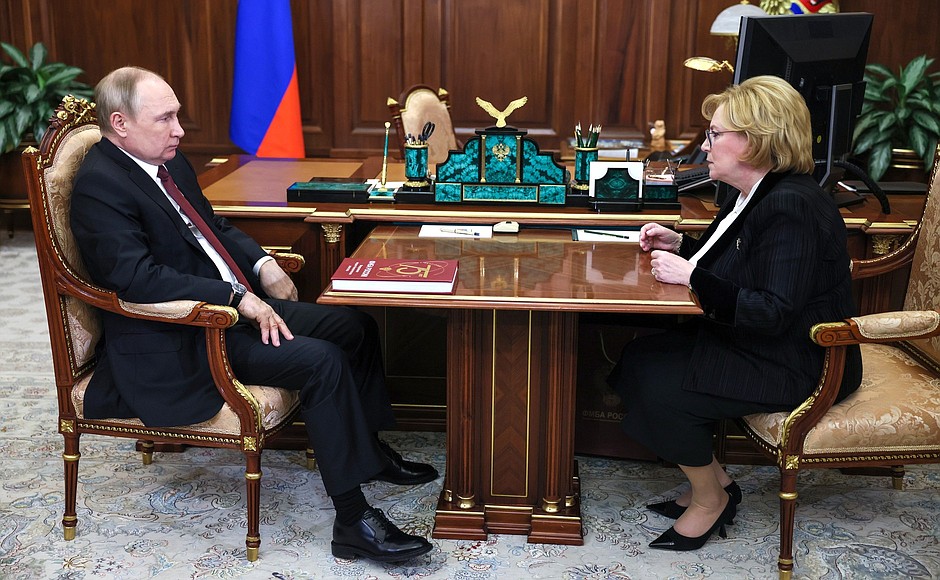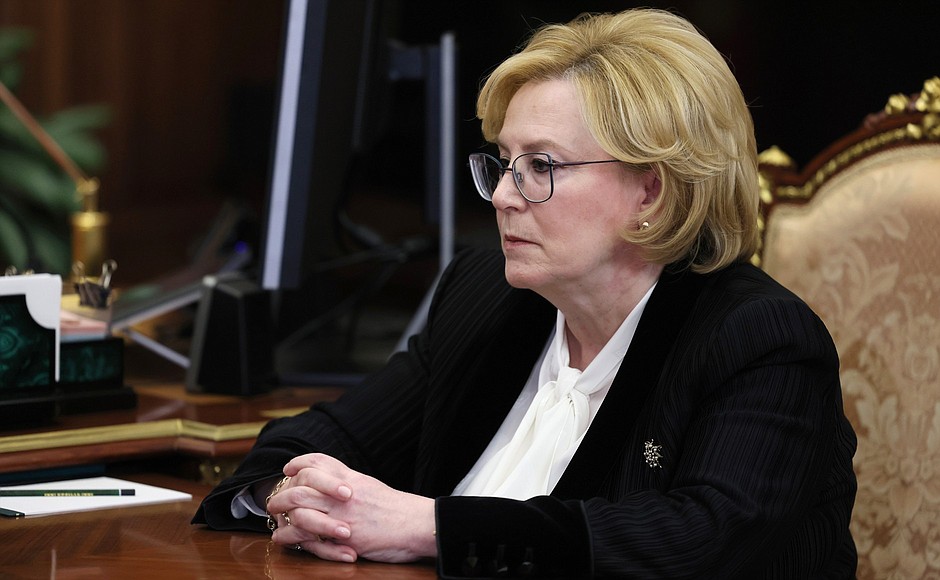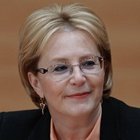President of Russia Vladimir Putin: Ms Skvortsova, the agency is 75 years old, and I would like to congratulate you and all employees once again and wish you all the best. The agency has made tremendous progress. We will get back to this at the gala event tonight, a bit later. In any case, I would like to thank you and all your staff for the results of your work.
FMBA Head Veronika Skvortsova: Thank you very much, Mr President. Thank you for this attention to our team and our veterans.
We did some work in the archives specifically for the 75th anniversary and managed to have a number of documents declassified. We compiled a book with a detailed history of the agency’s development and its main milestones. We cited some very interesting documents. We tried to include the glorious pages both from our history and from today – the main areas of our development. With your permission, we will give it to you. It contains interesting documents.
While studying the archive documents, we reached an interesting conclusion: the entire 75-year history of the agency is the history of our country’s technological progress. The 1940s – atomic and nuclear energy; missile and nuclear research in the late 1950s; space and manned flights in the 1960s; deep-water medicine in the 1970s; chemical disarmament and completely new approaches – chemical centres in the 1990s, and the entire blood system, and the coordination and organisation of top-level sports in the 2000s.
In the last few years, we have substantially expanded our functions as we began working on completely new areas that did not exist before like synthetic hybrid biology, genetic engineering, quantum technology and other new areas.
As a living organism, the agency is evolving, creating functional hubs, and our goal is to ensure priority development – to develop technology and study its influence on the human body, and to create a system of protection against some unpredictable risks and potential threats. The agency is working on this.
I must say that our teachers and predecessors established the fundamental principles of the agency’s activities. This is the fusion of science, medical practice and industry – both experimental and scaling – and the sanitary-epidemiological supervisory authority. This joint structure has a tremendous advantage – it makes it possible to reduce the innovation chain by several times and achieve a result, in addition to testing, validating and scaling it quickly.
Two years of the coronavirus has confirmed this again because during this short span of time, the agency’s centres developed high-precision diagnostic test systems and express tests, with which the Army has been equipped; including tests for self and mutual identification of highly dangerous infections; sensor detection devices and automated indicators of the presence of biological agents – the Army has these as well; different vaccine variants, including a universal vaccine against the coronavirus that has recently proven effective against all strains – from the initial Wuhan strain to the latest Omicron varieties; highly specific antivirus and anti-inflammatory preparations that remain effective during the virus’s mutations; antidotes against composite substances like carbon monoxide.
Our latest registered drug is Russia’s first antidote against carbon monoxide – zincosol. We are already receiving requests for this, not just from the Defence Ministry and the different military branches but also from the Emergencies Ministry, the Russian Guards, the Interior Ministry and our crews who fight fires and in certain high-risk areas.
Today, we have an enormous organisation with a network of 2,500 healthcare and research facilities. They are spread throughout the entire territory and in locations that parallel special zones and strategic facilities. We are alone in managing these territories and providing not only medical but also sanitary and epidemiological assistance.
Recently, starting with the onslaught of the novel coronavirus, we did a great deal to see that the system worked smoothly. In fact, we reorganised the entire network of medical institutions, created medical districts within the agency, and established regional centres to coordinate the entire network. They are located on this territory and provide round-the-clock tele-medical connectivity and quality control. Quality must be the same in the remote areas of the country.
The National Healthcare Project helped us very much. Thanks to this project, we were able to repair 200 organisations in three years. We purchased 55,000 units of equipment, and it is all in use. Of this number, over 3,000 units are heavy equipment costing over a million – tomography, radiography, fluorography and angiography machines. In short, we managed to reequip our network and upgrade our transport system, which is also very important.
We are already seeing the results because we have substantially reduced the fatality rate of our patients in just three years. We have one of the world’s lowest infant mortality rates – 1.7 per 1,000 births. We have a zero maternity mortality rate – not a single case in three years. The general death rate is also below pre-Covid figures, at 12.2 now.
There are two niche specialisations that the agency focuses on: industrial and mobile medicine. As concerns industrial medicine, we extensively cooperate with the Rosatom state corporation, working on nuclear towns. There is also the Integrated Institute of Nuclear Research in Dubna.
We have created model centres of industrial medicine. They are very comfortable, with capabilities for prompt high-level diagnostics of predisposition for diseases, or risk factors. Moreover, we rely on digital technology to monitor the condition of essential staff working at nuclear power stations, and so on.
Of course, I must say a few words about mobile medicine. While it is quite broad and vast, this system is fast-paced and mobile. Our rapid response squads, radiation, chemical, toxicological and biological detection crews arrive where they are needed within two hours.
It takes 24 hours to build mobile medical crews. They get prepared within 24 hours and go to the areas of disease outbreaks, industrial accidents and natural disasters. They provide support for the special military operation. Since February 25, our crews have worked first in the Belgorod and Rostov regions at the border as well as in northern Crimea, and since March, they have worked in the Donetsk People’s Republic, at three sites. Subsequently, our agency staff and Rosatom visited Zaporozhye to develop a monitoring system of the area surrounding the Zaporozhye Nuclear Power Plant.
Over this period, our teams have helped more than 35,000 wounded and affected adults and children, including more than 3,000 children. I would like to note here that our crews operate in armoured vehicles with diesel generators. It helps them to be autonomous and provide primary medical care, of any complexity, including technology-intensive care.
Vladimir Putin: The entire scope of medical care?
Veronika Skvortsova: Yes, this includes resuscitation, surgery and triage facilities, on wheels. Our crews not only save lives but prevent disability by saving limbs from amputation because they perform unique vascular surgery in field conditions.
We maintain intensive cooperation with our strategic partners, primarily Rosatom, Roscosmos and Rostec corporations and competent ministries. Thanks to our joint work, there has not been a single outbreak at any of the nuclear power plants; not a single space launch has been undermined. Over three years, there have been 57 launches from space launch centres, including seven manned and nine cargo space flights.
We keep working and we know what our responsibilities are.
Vladimir Putin: Good. Now let us talk more about specific areas of work.
Veronika Skvortsova: Thank you very much, Mr President.
<…>



